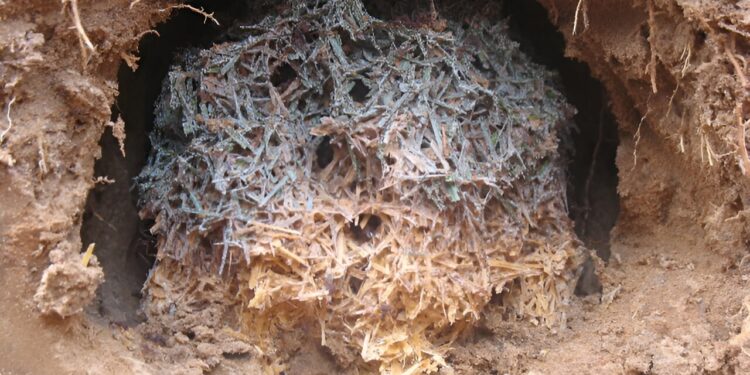An anthill found on a farm in Botucatu (São Paulo State, Brazil) houses a mushroom garden that includes grass leaves in addition to cultivated species. Credit: André Rodrigues/IB-UNESP
The event that wiped out the dinosaurs wasn’t so bad. The low-light environment caused by the meteor impact about 66 million years ago favored the spread of fungi that feed on organic matter, then abundant as plants and animals died en masse.
It was the perfect opportunity for the ancestor of a group of ants to begin cultivating these microorganisms, according to a study published October 3 in the journal Science.
“The origin of fungus-producing ants was relatively well understood, but a more precise timeline for these microorganisms was lacking. The work provides the smallest margin of error to date for the emergence of these fungal strains, which previously thought to be more recent,” says André Rodrigues, professor at the Institute of Biosciences at the State University of São Paulo (IB-UNESP) in Rio Claro, Brazil, and one of the authors of the study. ‘article.
The dating was made possible thanks to the analysis of so-called ultraconserved elements (UCE) in the genome of 475 fungal species cultivated by ants and collected in different regions of the Americas. UCEs are regions that remain in the genome throughout the evolution of a group, derived from its earliest ancestors.
“In this case, we were interested in the regions close to these elements. They show the most recent differences between species and make it possible to trace a fairly precise evolutionary lineage,” adds Pepijn Wilhelmus Kooij, researcher at IB-UNESP.
Using this method, it was possible to establish the near-simultaneous emergence of two distinct fungal lineages from the same ancestor of today’s leaf-cutter ants (a group known as Attini) 66 years ago. millions of years.
Scholars of fungal-ant mutualism have long argued that the beginning of this relationship defined the emergence of agriculture, tens of millions of years before humans began domesticating plants, just 12 years ago. 000 years.
The study also revealed the emergence of an ancestor of coral fungi, a second group that began to be cultivated by ants 21 million years ago. The fungus gets its name because it forms structures that resemble miniature colonies of marine corals.
The image enlarged a thousand times shows nutrient vesicles (gongylides) produced by the fungus Leucoagaricus gongylophorus, cultivated by the lemon leaf cutter (Atta sexdens). Credit: André Rodrigues/IB-UNESP
Mutualism
The results support the hypothesis that the fungi had already undergone pre-adaptation before being cultivated by the ants. It is likely, the authors point out, that the ancestor of the group of leaf-cutter ants lived in the immediate vicinity of the mushrooms, either inside the colonies, or even harvesting them from time to time to feed on them or of their products.
“But fungi were not an essential part of the ants’ diet. Pressure from the meteor impact may have transformed this relationship into an obligate mutualism, in which these fungi come to rely on ants for food and reproduce, while at the same time, ants rely exclusively on fungi as a food source,” explains Rodrigues.
Today, four different groups of ants cultivate four types of fungi. In some cases, insects even alter the growth of the crop so that it provides certain nutrients.
“When we grow them in the laboratory, the fungi take on the expected form of hyphae. However, inside the colony, one of these types of hyphae swells and forms grape-like structures, rich in sugars. We still don’t know how the ants do this,” explains Kooij.
For Mauricio Bacci Junior, professor at IB-UNESP and co-author of the article, the origin of mushroom cultivation probably indicates an adaptation to the nutritional shortage faced by ants at that time.
With the abundance of fungi spreading across what is now America and fewer options for food sources, those who already had possible relationships with ants eventually became more useful when cultivated.
“To feed itself, the fungus decomposes the organic matter carried by the ants. In turn, the ant consumes substances produced by the fungus that it could not obtain from any other source. It is as if the fungus were the “external stomach of the insect.” specifies the researcher, deputy director of the Research Center on Biodiversity Dynamics and Climate Change (CBioClima), one of the Research, Innovation and Dissemination Centers (RIDC).
After this founding event, mushroom ants, which previously lived in humid forests, underwent a second selective pressure with the expansion of the Cerrado savannah-type biome 27 million years ago. With more open and arid areas came a diversification of these agricultural insects, leading to the origin of today’s leaf-cutter ants.
This event certainly also favored the diversification of fungi, which became more efficient at producing food for ants and decomposing organic matter.
So much so that enzymes produced by fungi grown by ants are now being studied for their biotechnological potential to degrade not only organic matter but also other materials, including plastics.
More information:
Ted R. Schultz et al, The coevolution of fungus-ant agriculture, Science (2024). DOI: 10.1126/science.adn7179
Quote: The asteroid that wiped out the dinosaurs may have led to the invention of “ant agriculture” (October 6, 2024) retrieved October 7, 2024 from
This document is subject to copyright. Except for fair use for private study or research purposes, no part may be reproduced without written permission. The content is provided for informational purposes only.



